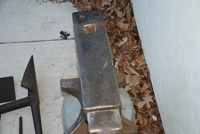

We get some here that when we tell them their anvil is over 100 years old tell us they won't touch it with a hammer! Which is ridiculous in my opinion. That brings to mind the difference between folks who see an anvil as a tool-to be treated right, but also to be used and those who see it as a symbol imbued with mystic history and should be appreciated for it's age and prior use. One I subsequently sold on, the other is in the "clean shop" though at just over 400 pounds it's a bit much for jewelry and armour work.the face was polished in the repair and so my best anvil for nonferrous work.)

(Not exactly true as I have had 2 anvils repaired in the 2 decades after I learned of the correct method. I have a slab of steel for that.Īctually by the time I learned that there was a good method of repairing anvils I had forgotten that my anvils needed repair their flaws had become "features". Having a large flat surface is handy to have for things like truing trivets and legs on things. In fact I use my anvil with some sway for straightening blades as I can push it just a bit too far and have it rebound to dead straight. Usually sway is not an issue as most of us are generally working across the face rather than along the face. They used high grade real wrought iron which is much more malleable than lower grades and so the problem with heavy work causing sway. This the the common "traditional" way to make anvils with the older the anvil usually consisting of more pieces forge welded together. Note that with angle iron you can grind an insert to "fit" perfectly.īy the way Peter Wrights are NOT cast they were forged from real wrought iron with a high carbon steel faceplate forge welded on. Hardy holes were generally hot punched, especially in older anvils and so may not be a true square or may be slightly angled compared to the face. You can also use angle iron to make a 2 sided insert with only 2 tabs.


 0 kommentar(er)
0 kommentar(er)
